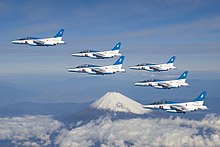Blue Impulse
| Blue Impulse | |
|---|---|

|
|
| Country: |
|
| Currently used aircraft type: | Kawasaki T-4 |
| Sponsor: | Air Self Defense Forces |
| Base airfield: | Matsushima Air Base |
| Founding: | 1960 |
| Colours: | White blue |
Blue Impulse ( Japanese ブ ル ー イ ン パ ル ス , Burū Inparusu ) or the 11th season ( 第 11 飛行 隊 , Dai-11 hikōtai , English 11 Squadron ), is the aerobatic demonstration team of the Air Defense Forces of Japan. Originally founded in 1960 as a team of four North American F-86 Sabers, the team switched to the Mitsubishi T-2 in 1982 and then to the Kawasaki T-4 in 1995 . The Blue Impulse are stationed at Matsushima Air Base, which was badly damaged on March 11, 2011 by a tsunami following the Tōhoku earthquake .
history

The first unofficial Japanese aerobatic team was formed in 1958 at the Hamamatsu air base . The team used F-86F Sabers, which did not have a specific color scheme. After four screenings, the team was disbanded. The next year the United States Air Force Thunderbirds visited Japan and inspired commanders of the Japan Air Self Defense Force (JASDF) to set up an official aerobatic team. In 1960 the new team was formed with four F-86F at Hamamatsu Air Base. Three of the pilots flew with the team from 1958.
The first demonstration by the new Tenryū team (named after a river near the air force base) was held on March 4, 1960 in Hamamatsu . But this name was difficult to pronounce in western languages, so the team was renamed Blue Impulse. The planes were equipped with smoke generators in five different colors: white, red, blue, green and yellow. They received color elements in light blue, blue, pink and gold for the team leader over their aluminum-colored base coat. In 1963, the team received the status of an official aerobatic team of the JASDF. Since this year, the team, which has now been supplemented by a solo pilot, has also been using the familiar white paint with the blue fuselage stripes and the same-colored markings on the tail unit.
At the opening of the Olympic Games in Tokyo in 1964, the Blue Impulse drew the Olympic rings with colored smoke in the air. In 1970, at the opening of Expo '70 in Osaka , the team drew "Expo '70" in the air. In February 1982, after 545 demonstrations, the Blue Impulse switched from the F-86F Saber to the Japanese Mitsubishi T-2 jets. The first air show with the new aircraft was held on June 25th at the team's new base, Matsushima Air Base . From this point on, two solo pilots will be used alongside the four-man formation.
On November 14, 1982 during a bombing maneuver at an airshow in Hamamatsu, the aircraft in position 4 did not have enough time to pull up and crashed into a building. The pilot was killed and 11 people injured on the ground. The flight demonstrations were suspended for a year. At the opening event of Expo '90 in Osaka, the Blue Impulse team drew the “Expo '90” logo in the air with smoke.
Blue Impulse suffered another accident on July 4, 1991, when aircraft No. 2 and No. 4 crashed during a training flight over the Pacific Ocean. The flight demonstrations were again suspended for a year.
The team's last demonstration with the Mitsubishi T-2 was in December 1995, after 175 demonstrations with this type of aircraft. The new Blue Impulse aircraft became the Japan-built Kawasaki T-4 trainers. The first show with these was on April 5, 1996. In 1997 the team made their first foreign debut at the Nellis Air Force Base Air Show in Nevada, USA. In 1998 Blue Impulse showed its program at the Olympic Winter Games in Nagano, Japan.
On July 4, 2000, aircraft no. 5 and 6 collided during a training flight and crashed. Three people were killed. The incident occurred about 25 km east of Matsushima Air Base.
The Blue Impulse also showed their program at the 2002 FIFA World Cup on June 4th at the opening of the game between Japan and Belgium.
Planes


| Aircraft type | origin | Number * | In service ** | comment |
|---|---|---|---|---|
| North American F-86F Saber |
|
34 | 1960-1981 | JASDF Technical Research Department. 5 airplane formation. |
| Mitsubishi T-2 |
|
11 | 1982-1995 | 4 AW 21 Sq. Technical research department. 6 airplane formation. |
| Kawasaki T-4 |
|
11 | 1995– | 4 units 11 Sq. 6 airplane formation. |
* Number of aircraft used by the Blue Impulse aerobatic team.
** Airplanes in service with the Blue Impulse aerobatic team.
References in pop culture
The team has been immortalized in their own video game, Aero Dancing featuring Blue Impulse , released in Europe under the title AeroWings .
The mercenaries of the Red Impulse air team and their leader from the anime series Kagaku Ninjatai Gatchaman refer to Blue Impulse by their names. When figures in Urusei Yatsura are hit with so much force that they fly away, they sometimes scream “Blue Impulse!”. The flight demonstration team called Green Impulse in the anime series Hyperdimension Neptunia derive their name from Blue Impulse.
literature
- Manfred Leihse: Artists in the sky - the history of the aerobatic teams from 1921 to today. Motorbuch Verlag, 1989, ISBN 3-87943-908-7